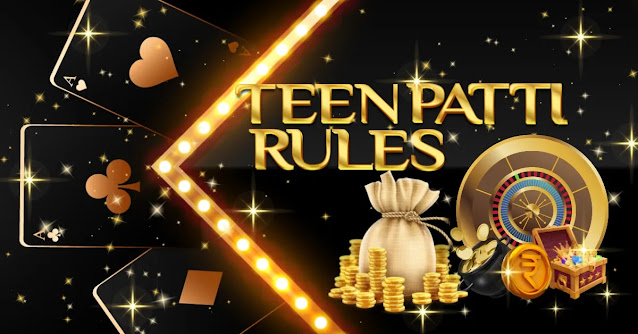Want to learn how to play Teen Patti Rules, a popular Desi card game in India, but don't know anyone who can teach you?
Don't worry about it. All the guidelines for Teen Patti are listed here.
One of India's most well-known card games is Teen Patti, a popular Desi card game. Don't give up on learning the rules of Teen Patti India and getting a feel for the game.
This card game had its initial popularity in India and has now spread throughout the rest of South Asia. It's a variation on Poker with three cards, called "flash" or "flush."
Learn How to Play Teen Patti Rules
A popular card game in India, Teen Patti can include anywhere from three to six players and is played with a standard 52-card deck (no jokers). As with other card games like Poker and rummy, Teen Patti India starts with the placement of a token. Players must agree on an initial bet before any cards are dealt.
Once everyone has placed their token and the total has been calculated, the dealer will distribute three cards to each player face down. The initial supply of tokens, known as the boot sum, is used to begin betting. The vessel sits atop the table.
A
The player and the sellers each receive three cards, and the action then moves to a call or raise. Both of these names should be recognizable to you if you've ever played Poker, a popular card game in India. Calling signifies continued play but no increase in the player's token; raising signals the player will add a token to the pot; play to win or lose more than the player's starting gaming token.
Whatever the case may be, remember that Teen Patti, a famous Desi card game played in India, is not the same as Poker. All tokens in Teen Patti app must be of the same value; if one player bets two coins and another bets four, the first player must increase his bet to six coins.
Prize money accumulates as the game goes, and the player with the highest ranking hand at the end of the hand wins. Ordering the cards from most to least significant is how it's decided.
Hand Ranks: 3 Patti Rules, A Popular Desi Card Game India
Teen Patti is a popular card game in India, and in order to win at it online, you need to have a better hand than your opponents. In the card game 3 Patti, sequences (or hands) are ranked from best to worst as follows:
Trail Rr Set (three of the same rank)
Regardless of color or suit, a trail, set, or trio can be constructed with any three identical cards in Teen Patti. An example of a high hand consisting of three aces is a trail consisting of one club, one diamond, and one heart.
Individually, the three Aces (A-A-A) of clubs, diamonds, and hearts all have the same hand rank. Ranks 2 and 3 are comprised of Queens, Jacks, 10s, and the remainder. The lowest ranking pair is 2-2-2.
Pure Sequence Or The Straight Flush
Teen Patti players in India call this particular sequence of three hands (or hand configuration) the pakki round. Three cards in a row all share the same suit. In the standard game, the greatest possible ranking for a pure sequence of cards is an A-2-3 of hearts, diamonds, spades, or clubs.
But in other contexts, the letters A-K-Q are considered the most important. By the end of the list, 4-3-2 has fallen to last place. In case you hadn't noticed, pure sequences of the form 2-A-K and K-A-2 are both invalid.
Sequence (straight or run)
In the card game Teen Patti, a run or straight sequence is the equivalent of a pure sequence. The hand consists of three consecutive cards of varying suits. The traditional best hand also consists of the cards A-2-3.
But with the tweak, the sequence becomes A-K-Q. The 4-3-2 hand is the worst of the series. The sequences 2-A-K and K-A-2 are clearly not possible as a straight sequence.
Color
Three cards of the same suit in any order constitutes a color or flush in the card game Teen Patti. The highest possible hand in this sequence is spades, clubs, diamonds, or hearts A-K-J, followed by spades A-K-10, diamonds A-K-9, and so on. The color or flush sequence of 5-3-2 is the worst possible hand.
Pair (two cards of the same rank)
If you get two cards that are the same rank, it doesn't matter what color they are. For Teen Patti, a pair of Aces of any color or suit is the best possible hand. In a hand where both players have a pair, the winner is decided by the value of the third card.
In terms of order, A-A-K is at the top, while 2-2-3 is at the bottom.
High Card
Teen Patti's high card resembles a flush in appearance. The hand is made up of three cards from various suits that are not in any particular order. The best hand is A-K-J, while the worst is 5-3-2. If two players share a common high card, the higher-ranking hand is determined by the next high card.
Start The Game
Before we get into the intricacies, check out this video to learn how to play Teen Patti game.
Rounds Of Gaming
You can choose to play Chaal, a popular Desi card game India, (see the cards) or blind before placing your initial token (not seeing the cards).
You must bet at least the ante when playing blind, but no more than twice the ante. If the ante is 15, for instance, the lowest possible token bet is $15. At most, 30 tokens can be used per wager.
If you want to keep playing chaal, an extremely popular card game in India, you need to double the bet of the blind players. Bet no more than four times the total, though.
These rules of play apply throughout the entirety of the round of the Indian card game popular in the West, known as Desi.
You can either call or raise every time you place a token from now on:
The price of a call equals the sum of the largest tokens from each round times the total number of rounds played.
To elevate, a token's value must increase above that of all other players. While playing chaal, you may only place 4 of the highest value token. When playing blind, you are limited to only playing twice as many of the highest token.
The gaming will continue until one of the following events occurs:
All of the other players have now given up and folded. You will win the full pot if you are the lone player still in the hand.
Everybody folds except for the final two. The situation allows for a show to be requested by one of the two remaining participants. If this occurs, both players must expose their hands and compare them. The winner is the one who has the best hand.
The Show
The showdown is requested when all players except two have folded. If this happens, both players must show their hands. Here are the guidelines for the program:
A show can only happen when there are only two players left.
If only two players remain, any of them can request a show. They must both place 1x the current amount.
No player (including the players themselves) is permitted to look at their cards before paying for the show.
If only two players remain, any of them may request a show. They will each pay twice the current token value.
A Blind player can request a show from another player.
The blind token must be 1x the current token's value. Blind players must wager twice as much as players.
When a player is blind, they are unable to request a show. The player has only two options: play or drop out.
The cards of both players are revealed during the show. The player with the highest-ranking hand wins the pot.
If both players have equal hands, the player who paid for the show loses.
The winner becomes the dealer in the next game.
Compromise
If you’re playing Chaal, you can also ask for a compromise, often known as a side show. The following are the guidelines for reaching an agreement:
To begin, all players must deposit a minimum amount (Ante).
When it's your turn to place your next token, you can ask the player who placed before you (the person on your left side) for a compromise. You can, however, only do so if the player in front of you is playing Chaal.
It's best if you put the previous player's current amount.
The other player is free to accept or reject the compromise.
If the other player accepts the compromise, you must both compare your cards. The player with the lowest-ranking hand must fold. If the cards are tied, the person who asked for the compromise must fold.
If the other player rejects the compromise, the turn is passed to the next player.
Different Rules Apply to Teen Patti Variations
Teen Patti, a well-liked card game in India, is prohibited due to the restrictions described herein. The 3 Patti game, on the other hand, can take many different shapes.
There are many variants of the game, each with slightly different rules. Our page for the card game Teen Patti, which is widely played in India, has strict guidelines for all possible variations on the theme.
Is everyone in India set to play Teen Patti? Get the 3 Patti Game App right now! Visit our website Hobi Games, if you are interested in learning and discovering more stuff about this topic.
.png)


Mga Komento
Mag-post ng isang Komento